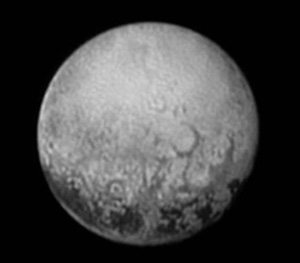Pluto flyby Canadian contribution

Photo taken by New Horizons on July 11 when the spacecraft was 4 million kilometres away from Pluto (Credit: NASA/JHUAPL/SWRI)
2015-07-14 – A Pluto Flyby with a Canadian Touch
Launched in 2006, New Horizons, the fastest spacecraft ever built, continues its long journey to the Dwarf Planet Pluto over five billion kilometres away from the Earth. The probe has been conducting a study of Pluto and its moons since early 2015, and today marked its closest approach of the celestial body, zooming past the dwarf planet at a mere 11,265 km at 7:49 a.m. EDT. New Horizons is set to help further humankind's understanding of the origins of our solar system and of the make-up and evolution of ice dwarf planets like Pluto.
Canadian engineers and scientists contributed to make this incredible journey possible.
Frédéric Pelletier, a former Canadian Space Agency engineer now working at KinetX, is one of them. As the Deputy Navigation Team Chief for the mission, Frédéric works in collaboration with NASA to compare images of Pluto and its moons taken by the spacecraft's cameras and determine where the spacecraft is relative to its expected position. Using those calculations, Frédéric and his team performed the necessary trajectory-correction maneuvers to make sure New Horizons reached the dwarf planet and beamed back never seen before images of one of the most distant "planet" in our solar system.
During its approach towards Pluto, New Horizons had to be careful to avoid collision hazards, including any previously unseen rings, small moons, rocky dust or icy space debris. To avoid these hazards, space mission managers relied on a high-precision position reference system provided by the Canada-France-Hawaii Telescope (CFHT) and its MegaPrime camera.
Using calibration methods pioneered at the Canadian Astronomy Data Centre (CADC) and a system developed by National Research Council of Canada's (NRC) Stephen Gwyn, the MegaPrime camera was calibrated more accurately than any other wide-field imaging camera currently in operation.
Congratulations to the enlarged New Horizons team for this historic accomplishment!
Note * With material from KinetX and the National Research Council of Canada.
- Date modified: